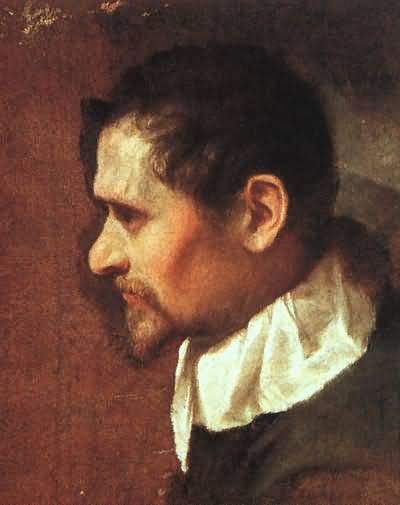

Annibale Carracci Biography
Annibale Carracci (1560 - 1609)
Carracci, Lodovico, Agostino and Annibale, three celebrated Italian painters, were born at Bologna in 1555, 1557, and 1560 respectively. Lodovico, the eldest, son of a butcher, was uncle to the two younger, Agostino and Annibale. Sons of a tailor, and had nearly finished his professional studies before the others had begun their education. From being a reputed dunce, while studying under Tintoretto in Venice, he gradually rose, by an attentive observation of nature and a careful examination of the works of the great masters - preserved at Bologna, Venice, Florence and Parma, to measure himself with the teachers of his day, and ultimately projected the opening of a rival school in his native place. Finding himself unable to accomplish his design without assistance, he sent for his two nephews, and induced them to abandon their handicrafts (Agostino being a goldsmith, and Annibale a tailor) for the profession of painting. Agostino he first placed under the care of Fontana, retaining Annibale in his own studio; but he afterwards sent both to Venice and Parma to copy the works of Titian, Tintoretto and Correggio, on which his own taste had been formed.
On their return, the three relatives, assisted by an eminent anatomist, Anthony de la Tour, opened, in 1589, an academy of painting under the name of the incamminati (or, as we might paraphrase it, the Right Road), provided with numerous casts, books and bassi-rilievi, which Lodovico had collected in his travels. From the affability and kindness of the Carracci, and their zeal for the scientific education of the students, their academy rose rapidly in popular estimation, and soon every other school of art in Bologna was deserted and closed. They continued together till, at the invitation of Cardinal Farnese, Annibale and Agostino went to Rome in 1600 to paint the gallery of the cardinal's palace. The superior praises awarded to Agostino inflamed the jealousy of Annibale, already kindled by the brilliant reception given by the pupils of the Incamminati to Agostinos still highly celebrated picture of the Communion of St Jerome, and the latter was dismissed to Parma to paint the great saloon of the Casino.
Here he died in 1602, when on the eve of finishing his renowned painting of Celestial, Terrestrial and Venal Love. Annibale continued to work alone at the Farnese gallery till the designs were completed; but, disappointed at the miserable remuneration offered by the cardinal, he retired to Naples, where an unsuccessful contest for a great work in the church of the Jesuits threw him into a fever, of which he died in 1609. Lodovico always remained at his academy in Bologna (excepting for a short visit to his cousin at Rome), though invited to execute paintings in all parts of the country. He died in 1619, and was interred in the church of Santa Maria Maddalena. The works of Lodovico are numerous in the chapels of Bologna. The most famous are: The Madonna standing on the moon, with St Francis and St Jerome beside her, attended by a retinue of angels; John the Baptist, St Jerome, St Benedict and St Cecilia; and the Limbo of the Fathers. He was by far the most amiable of the three painters, rising superior to all feelings of jealousy towards his rivals, and though he received large sums for his productions, yet, from his almost unparalleled liberality to the students of the academy, he died poor.
With skill in painting Agostino combined the greatest proficiency in engraving (which he had studied under Cornelius de Cort) and high accomplishments as a scholar. He died not untroubled by remorse for the indecencies which, in accordance with the corruption of the time, he had introduced into some of his engravings. The works of Annibale are more diversified in style than those of the others, and comprise specimens of painting after the manner of Correggio, Titian, Paolo Veronese, Raphael and Michelangelo. The most distinguished are the Dead Christ in the lap of the Madonna; the Infant and St John; St Catherine; St Roch distributing alms (now in the Dresden gallery); and the Savior wailed over by the Manes, at present in possession of the earl of Carlisle. He frequently gave great importance to the landscape in his compositions. The reputation of Annibale is tarnished by his jealousy and vindictiveness towards his brother, and the licentiousness of his disposition, which contributed to bring him to a comparatively early grave.
Return to the Carracci Gallery
Please spend some time roaming our other galleries.
Artist Galleries A - F
Artist Galleries G - P
Artist Galleries Q - Z
Home Galleries by Subject Galleries by Artist Contact Us How to Order

All Rights Reserved to Canvas Replicas. 2016, 2017